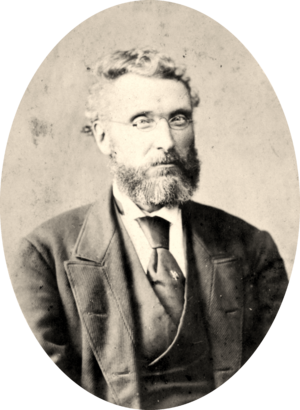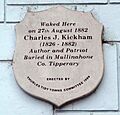Charles Kickham facts for kids
Quick facts for kids
Charles Kickham
|
|
|---|---|

Kickham, c. 1870s
|
|
| Born | Charles Joseph Kickham 9 May 1828 Mullinahone, County Tipperary, Ireland |
| Died | 22 August 1882 (aged 54) Dublin, Ireland |
| Occupation | Writer |
| Language | English |
| Nationality | Irish |
| Period | 1850s–1880s |
| Genre | Fiction, poetry, journalism |
| Subject | Social issues |
| Relatives | John O'Mahony |
| Signature | |
| President of the Irish Republican Brotherhood | |
| In office 15 January 1873 – 22 August 1882 |
|
| Preceded by | J. F. X. O'Brien |
| Succeeded by | John O'Connor Power |
Charles Joseph Kickham (born May 9, 1828 – died August 22, 1882) was an Irish writer, poet, and journalist. He was also a very important member of the Irish Republican Brotherhood, a group that wanted Ireland to be independent from British rule.
Contents
A Young Life in Ireland
Charles Kickham was born in Mullinahone, County Tipperary, Ireland, on May 9, 1828. His father, John Kickham, owned a shop and was known for his love of Ireland. His mother, Anne O'Mahony, was related to a famous Irish leader named John O'Mahony.
When Charles was 13, an accident with gunpowder left him mostly deaf and nearly blind. Despite this, he was educated in his local area. He was very interested in the idea of Ireland becoming independent. He often heard these ideas discussed in his father's shop and among friends.
Learning from The Nation
From a young age, Charles believed strongly in Irish independence. He learned a lot from a newspaper called The Nation, which started in 1842. Charles's father would read the paper aloud every week for the family. This included speeches and reports about groups working for Irish freedom.
Charles started writing for The Nation when he was 22. His first poem, The Harvest Moon, was published in 1850. He wrote many other popular poems like Rory of the Hill and Slievenamon. He also wrote for other newspapers such as the Celt and the Irishman. Many of his poems appeared in the Irish People, a newspaper for the Irish Republican Brotherhood. He sometimes signed his work with his initials, his full name, or the pen names "Slievenamon" and "Momonia."
Joining the Fight for Freedom
In 1848, when Charles was 20, there was a rebellion in Ireland. Charles was a key member of a group called the Confederation Club in Mullinahone. He helped start this club. When leaders like William Smith O'Brien came to Mullinahone, Charles joined them. He even helped make pikes (a type of weapon) and rang the chapel bell to gather people. This was when he first met James Stephens, another important Irish leader.
After the 1848 rebellion failed, Charles had to hide for a while. When things calmed down, he returned home. He enjoyed fishing and writing. He loved books by authors like Tennyson, Dickens, and Burns.
The Irish Republican Brotherhood
In 1857, a message arrived from New York for James Stephens. It asked him to start an organization in Ireland. On March 17, 1858, the Irish Republican Brotherhood (IRB) was officially formed. This group aimed to achieve Irish independence through a rebellion. Charles Kickham was one of the first members, along with Stephens and others.
The Irish People Newspaper
In 1863, James Stephens decided to start a newspaper called The Irish People. It was funded by Irish groups in America. The first issue came out on November 28, 1863. Charles Kickham was a main writer for the paper, along with Thomas Clarke Luby and Denis Dowling Mulcahy. John O'Leary was the editor.
The newspaper was very important for sharing the IRB's ideas. Charles Kickham wrote many articles, including "Leaves from a Journal," which showed his great writing skills. He also wrote articles that explained the IRB's views on politics and the role of priests in the independence movement. He believed people should understand the difference between a priest's religious role and their political opinions.
Arrest and Trial
In 1865, plans for a rebellion in Ireland were discovered by the authorities. On September 15, 1865, the offices of the Irish People newspaper were raided. John O'Leary, Thomas Clarke Luby, and Jeremiah O'Donovan Rossa were arrested. Charles Kickham was caught a month later after trying to hide. James Stephens was also arrested but managed to escape to France.
On November 11, 1865, Charles Kickham was found guilty of opposing British rule. He was sentenced to fourteen years in prison. During his trial, he bravely stated that he was simply doing his duty for Ireland. He believed that Ireland's treatment by England was wrong and that Irish people had the right to fight for their freedom. He quoted a poet, saying that while words can inspire, only a soldier's actions can achieve freedom.
The judge expressed sympathy for Charles but still gave him a long sentence. Charles Kickham spent time in the Invalid Prison at Woking from 1866.
In 1869, he was given a special pardon by Queen Victoria because of his poor health. After his release, he became the Chairman of the Supreme Council of the IRB. This meant he was a top leader of the movement. Despite his hearing and vision problems, he was a very good speaker and leader of meetings. He used an ear trumpet to hear and had to hold books very close to his eyes to read.
Knocknagow and Its Impact
Charles Kickham's most famous novel, Knocknagow, was published in 1873. It tells the story of Irish farmers and how they were treated by landlords. The book showed how landlords often didn't care about their tenants, and how their agents were greedy. This led to people losing their homes, moving away, and living in poverty.
The novel also showed the good side of Irish life, like strong communities and music. It became very popular because it showed both the struggles and the good qualities of Irish society. For fifty years after it was published, Knocknagow was one of the most loved books in Ireland. Even young Michael Collins, a future Irish leader, was said to have cried while reading about the farmers' hardships in the book. Many people called Knocknagow "the national Irish novel."
Legacy and Death
Charles Kickham wrote three well-known stories that showed Irish life in a caring way. They captured the simple faith, joys, sorrows, and humor of the Irish people. Besides Knocknagow, he wrote Sally Cavanagh, which showed the problems of landlordism and emigration. He also wrote For the Old Land, about a small farmer's family.
John O'Leary, a fellow Fenian, said that Charles Kickham knew the Irish people incredibly well. He understood their strengths and weaknesses but was always loyal to them. John Devoy, another important Fenian, called him "the finest intellect in the Fenian movement."
Charles Kickham died on August 22, 1882, at the age of 54. He passed away in Dublin and was buried in his hometown of Mullinahone, County Tipperary.
Images for kids
-
Denis Dowling Mulcahy, Thomas Clarke Luby and John O'Leary



